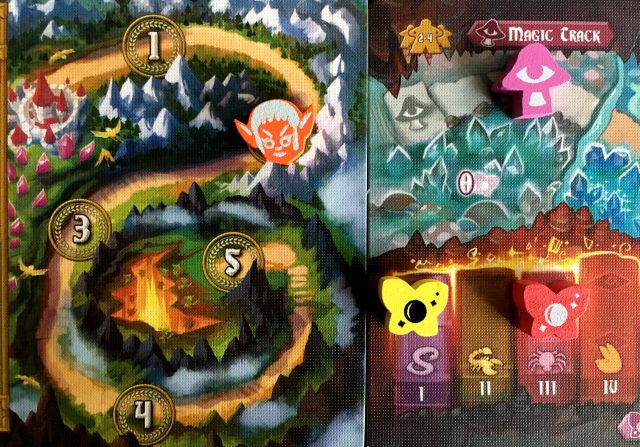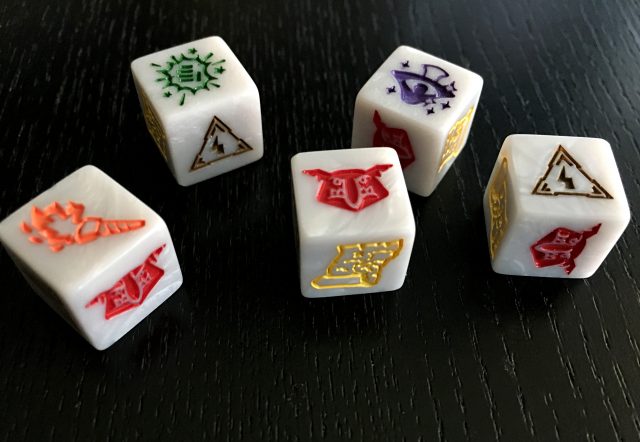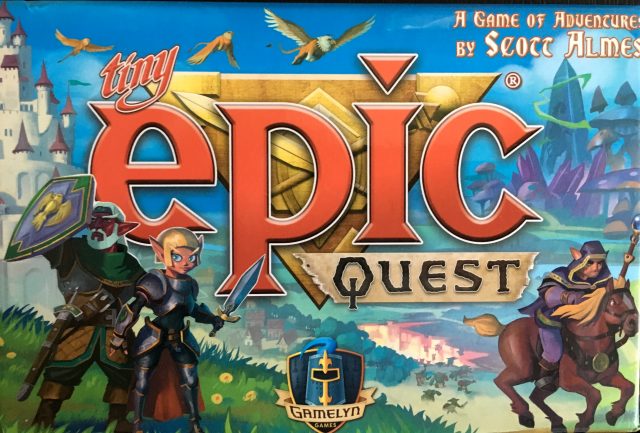Scott Almes is some kinda genius.
Almes, the brains behind Gamelyn Games’ Tiny Epic series, really seems to understand how to pack a lot of punch into games that take up a minimum of shelf space (see also Best Treehouse Ever and Harbour). How does he do it? Lack of volume!
With Tiny Epic Quest, Almes really busts things open with a design that is graphically so inviting, a theme which rings all the right nostalgia bells without risking any lawsuits, and gameplay which is full of tough decisions and tense moments, all playable in less than two hours.
No, seriously, how do I really feel about it?
 I admit, in this case it’s hard for me to separate the gameplay with the visuals. But I suppose, as in many great games (Scythe, 7 Wonders: Duel), the artwork and iconography don’t just help set the tone and establish theme–they facilitate and enhance gameplay. As a Kickstarter backer I had early access to a print-and-play of Tiny Epic Quest and duly printed it and tried it out, but it was just…okay. I could see the bones of the game were good, but I didn’t get drawn in.
I admit, in this case it’s hard for me to separate the gameplay with the visuals. But I suppose, as in many great games (Scythe, 7 Wonders: Duel), the artwork and iconography don’t just help set the tone and establish theme–they facilitate and enhance gameplay. As a Kickstarter backer I had early access to a print-and-play of Tiny Epic Quest and duly printed it and tried it out, but it was just…okay. I could see the bones of the game were good, but I didn’t get drawn in.
The final components really do make a difference, even with no rules changes. Everything from the artwork on the cards to the dice–and most especially the customizable meeples and attachable Items–just screams “Play me!” And from personal experience, I can tell you that having this on the table at an FLGS games night attracts onlookers like flies to…stuff.
 Tiny Epic Quest gives off a “Legend of Zelda” vibe–especially if you get the “Golden Mushroom” expansion. Think Breath of the Wild on a much smaller scale, and with three Links at your command instead of just one. It’s a sandbox open world in miniature, with four ways to get Victory points:
Tiny Epic Quest gives off a “Legend of Zelda” vibe–especially if you get the “Golden Mushroom” expansion. Think Breath of the Wild on a much smaller scale, and with three Links at your command instead of just one. It’s a sandbox open world in miniature, with four ways to get Victory points:
Oh, did I mention you only have five turns to do all this stuff? That’s really not a heckuva long time, fellow questers. You’re gonna have to figure out the most efficient way to complete your tasks, probably concentrating on just two of the four categories for the first couple of turns til you level up a bit.
Each turn is composed of Day and Night phases. During the Day, everyone moves around the island using the draft-and-follow mechanic adapted from Tiny Epic Kingdoms. In turn, each player picks one of five possible movement methods, and then each player can either use the same one or sit Idle. This is the part where you earn your Movement Quests and set up for after the sun sets.
 The Night Phase is when the goblin-punching, temple-raiding, and spell-larnin’ happen, using a dice-rolling push-your-luck mechanism that shares the love and the pain. In turn, each player rolls the dice and depending on how they land players may accrue damage, gain energy, explore temples, and duke it out with the goblins. As well, over time, the Magic Level of the land rises–which is good, because it’s necessary to learn spells, but it’s also bad, because the higher it goes, the more damage Goblins do, and if any player hits zero health they get Exhausted and have to return to their home castle, abandoning all progress they may have made. You don’t wanna get Exhausted, trust me. After five rounds everyone totes up their points and a winnah is declared.
The Night Phase is when the goblin-punching, temple-raiding, and spell-larnin’ happen, using a dice-rolling push-your-luck mechanism that shares the love and the pain. In turn, each player rolls the dice and depending on how they land players may accrue damage, gain energy, explore temples, and duke it out with the goblins. As well, over time, the Magic Level of the land rises–which is good, because it’s necessary to learn spells, but it’s also bad, because the higher it goes, the more damage Goblins do, and if any player hits zero health they get Exhausted and have to return to their home castle, abandoning all progress they may have made. You don’t wanna get Exhausted, trust me. After five rounds everyone totes up their points and a winnah is declared.
Tiny Epic Quest is not a gateway game. It takes about half an hour to explain it to the uninitiated (I know; I timed it) and you have to pay attention not only to your own position and progress but also your opponents’. But at five rounds it definitely does not outstay its welcome; on the contrary, it’s got “play me again” written all over it. The solitaire mode is a bit dull (try to beat a specified score in five rounds) but not easy, even at the lowest level, and is a great way to learn the game and get better at it.
Until now I would have said Tiny Epic Galaxies was my favorite of the series, especially with the expansion. But I have to say that if I had to choose, I would pick Tiny Epic Quest as the best game of the series. So far. But who knows? Scott Almes may deliver something better yet down the line.
Yeah I agree this game really surprised me. I got hooked by the itemeeples. But the game is inviting strategic and fun!